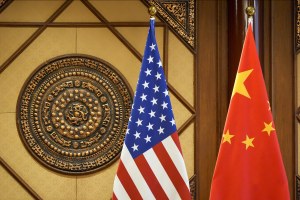The public's top priorities for the US-China relationship moving forward: avoiding war and maintaining a technological edge.
Over the past two US presidential administrations, relations with China have become significantly strained. What began as an effort under the Trump administration to reset America’s trade relations with China has transformed into a wide-reaching competition for economic and military influence around the world.
A series of surveys conducted by the Chicago Council on Global Affairs and Ipsos, including the annual 2024 Chicago Council Survey, find that this competition has dramatically affected Americans’ views of China—now at the lowest level recorded in Council polling dating back to 1978. Along those lines, majorities of Americans want to limit the growth of China’s power, view China as a US rival, and say US-China trade weakens US national security. However, Americans are also keenly aware of the potential costs of a war between the two nuclear powers and say avoiding a military conflict with China is their top goal for US-China relations.
Key Findings
- American views of China have hit an all-time low in Council polling: 26 out of 100 on the Council’s 0–100 feeling thermometer, down from 32 in 2022.
- A majority of Americans (55%) say the United States should actively work to limit the growth of China’s power, while four in 10 (40%) say the United States should undertake friendly cooperation and engagement with China.
- Americans’ top goals for US-China relations: avoiding a military conflict (69% very important) and maintaining the US high-tech edge (60%).
- Half of Americans (49%) view China as more influential than the United States in Asia (30% equally influential, 21% US more influential).
- A majority of Americans (56%) say US-China trade does more to weaken US national security (39% more to strengthen).
Views of China Hit All-Time Low in Chicago Council Survey History
As US-China relations have taken a sharp turn toward increasingly comprehensive competition, US President Joe Biden and Chinese President Xi Jinping have made it a point to engage one another in leader-to-leader talks. The United States has been clear that it wishes to manage the emerging strategic competition with China, and, as American officials put it, to establish guardrails on the relationship. Unfortunately for the Biden administration, Beijing has broadly rejected such efforts.
Guardrails or no, the number of significant problems between the United States and China only seems to grow with each passing year. To existing challenges of China’s support for Russia’s war in Ukraine, its increasingly aggressive actions against US allies in the South China Sea, and its extensive military drills around Taiwan, Beijing can now add the extensive US restrictions on Chinese access to high-end semiconductors and the prohibitive US tariffs imposed on Chinese electric vehicles. Perhaps the lone bright spots in recent years have been the reestablishment of military-to-military communications between the two powers and the return of pandas to zoos in San Diego and Washington, DC.
This downturn in relations, the concomitant centering of the many challenges in the US-China relationship, and the escalated rhetoric of the 2024 presidential campaign between Vice President Kamala Harris and former President Donald Trump have all had a significant impact on how the American public feels about China. On the Council’s feeling thermometer, on which a zero represents a very cold, unfavorable feeling and 100 a very warm, favorable feeling, China receives an average score of 26, an all-time low in Council polling dating back to 1978—when the United States and China had yet to reestablish official diplomatic relations.
Nor is this decline in favorability of China driven by one party over another: Democrats (29), Independents (27), and Republicans (20) all report record low views of China. Across party lines, views of China have turned significantly more negative in recent years, starting with a sharp downturn in 2020 and remaining at or near record lows each successive year.
Majorities across Party Lines View United States and China as Rivals, Not Partners
Matching their negative views of China overall, a majority of Americans (74%) describe the United States and China as mostly rivals, including very similar majorities across party lines. American opinion on the US-China relationship was divided for many years, from 2006 through spring 2018. By early 2019, however, Council polling found Americans shifting toward the view that the two countries were rivals, and the public has maintained this view for the past five years.
Americans View China’s Rise as a Threat; Less Concerned about Economic Competition
Though American views of China are at record lows, they are also slightly less likely to view China’s rise as a world power as a critical threat to the United States. Just over half of Americans (53%) say so, down from 58 percent in 2023. As has been the case for the past several years, Republicans (67%) remain notably more concerned about China than Independents (48%) or Democrats (46%).
This greater level of concern for Republicans persists across different specific potential threats that China may pose to the United States. This includes China’s territorial ambitions, which six in 10 Republicans (61%) view as a critical threat. Americans overall (48%) are somewhat less likely to view China’s rise as a threat, as are Democrats (49%) and especially Independents (36%).
Interestingly, though the public supports many efforts to alter the US-China economic relationship, Americans also say they are not particularly concerned about economic competition from China. Only a third (33%) view it as a critical threat, with Republicans (45%) more concerned than Independents (30%) or Democrats (25%).
Majority Say US Should Actively Work to Limit Growth of China’s Power
Perhaps reflecting these concerns about the development of China as a world power, a majority of Americans (55%) say the United States should actively work to limit the growth of China’s power, while four in 10 (40%) say the United States should undertake friendly cooperation and engagement with China. Republicans are solidly on the side of limiting China’s rise (67%, vs. 28% engagement), and half of Independents agree (50%, 44% engagement). For their part, Democrats are divided: similar proportions favor limiting China’s rise (49%) and pursuing cooperating and engagement (47%).
However, if given a third option—to undertake friendly cooperation when appropriate and actively limit China’s growth when appropriate—a majority of Americans (55%) opt for this approach, including majorities of Democrats (61%), Independents (54%), and Republicans (52%).
Americans Not Paying Close Attention—but Want More from Leaders
In a year with numerous other issues and conflicts competing for public attention, China has taken a back seat to other topics for many Americans. As the 2024 Chicago Council Survey shows, when asked how closely they are following various issues in the news, the issue of US-China relations (44%) falls well below every other item asked about. That includes other foreign policy issues such as immigration (58%), the conflict between Israel and Hamas (51%), and the Ukraine-Russia conflict (46%). Republicans (51%) are somewhat more likely than Democrats (42%) or Independents (41%) to say they are following US-China news at least somewhat closely.
However, that relative inattention doesn’t mean Americans want their leaders to pay less attention to China. In fact, roughly half (47%) say US leaders are not giving the issue of US competition with China enough attention, including a majority of Republicans (62%) and a plurality of Independents (46%). By contrast, half of Democrats (50%), and four in 10 Americans overall (40%), say US leaders are paying about the right amount of attention to US-China competition. Few (12% overall) think America’s leaders are paying too much attention to the issue.
Americans View China as Most Influential Country in Asia
One potential factor behind Americans’ desire for their leaders to pay more attention to China: the sense that the United States is falling behind China—at least in Asia. When asked to rate the influence of nations in Asia on a zero to 10 scale, with zero meaning they are not at all influential and 10 meaning they are extremely influential, Americans rate China an average of 7.9—a step above the United States and Japan (7.0 and 6.6, respectively).
A closer look at the data finds that half of Americans (49%) rate China’s influence in Asia above that of the United States. Three in 10 (30%) give the two nations equal influence ratings in Asia, while two in 10 (21%) say the United States is more influential in Asia than China. Republicans (58%) are somewhat more likely than Democrats or Independents (47%) to view China as the more influential nation.
Americans View US-China Trade as Harmful to US National Security
Trade remains a key factor in the US-China relationship, and for years it was seen as a stabilizing feature. However, the experiences of the COVID-19 pandemic and new concerns about China’s control over critical supply chains have highlighted the potential downsides of such economic interdependence. Today, a majority of Americans (56%) say trade between the United States and China does more to weaken US national security (39% say it does more to strengthen US security). Seven in 10 Republicans (69%) view US-China trade ties as weakening US security, as do a majority of Independents (54%). Democrats, however, are divided: similar proportions say that US-China trade strengthens (49%) and weakens (46%) US national security.
Top Goals of US-China Relations: Avoid War, Maintain US Tech Edge
While Americans are certainly concerned about China’s rise, and particularly about the US-China economic relationship, they are also not eager for a war with Beijing. Across party lines, Americans’ most important goal in the US-China relationship is avoiding a military conflict with China. Seven in 10 Americans (69%), including similar majorities of Democrats (73%), Independents (69%), and Republicans (66%), say this is a very important goal for the United States. Not far behind in American priorities: maintaining the United States’ technological edge in high-tech industries. Six in 10 Americans overall, and similar majorities across party lines, say this is a very important goal.
Other potential objectives for the US-China relationship are more divided along party lines. While a majority of Democrats (57%) say it is very important for Washington to work with Beijing on issues of common concern such as climate change or arms control, only 29 percent of Republicans and 42 percent of Independents agree. Similarly, while nearly half of Democrats (47%) say it is very important to promote human rights and democracy in China, fewer Independents (32%) or Republicans (28%) feel the same way.
Partisan Divisions on US-China Policy
Matching the bipartisan consensus on the need to maintain the US high-tech edge over China, eight in 10 Americans favor prohibiting US companies from selling sensitive high-tech products to China (79%, up from 71% in 2021), including large majorities across party lines.
However, opinions on other limitations on US-China exchanges is far more polarized by partisanship, with Republicans consistently more supportive of reductions in these exchanges while Democrats are opposed to such policies. Additionally, support for broad trade restrictions has declined from 2021, possibly because of greater concerns about costs following the experience of the higher inflation of the early 2020s.
For example, a majority of Americans (55%, down from 62% in 2021) favor increasing tariffs on products imported from China. While nearly eight in 10 Republicans (78%) support this approach, only half of Independents (50%) and four in 10 Democrats agree (39%).
Similarly, only a minority of Americans (45%) favor significant reductions in US-China trade, even if it leads to greater costs for Americans. While two-thirds of Republicans (63%) back this kind of broad reduction in trade, only four in 10 Independents (40%) and a third of Democrats (35%) agree.
Finally, 46 percent of Americans favor limiting the number of Chinese students studying in the United States, unchanged from 2021. This includes two-thirds of Republicans (65%) but only minorities of Independents (43%) and Democrats (32%).
Bipartisan Preference for Domestic Production and Subsidies over Cheaper Chinese Imports
But concerns about costs are not the only factor shaping opinion about US-China trade. The type of industrial policy that has recently come back into vogue in the United States—most prominently in the semiconductor and green tech industries—is broadly popular with the American public. Majorities of Americans across party lines favor domestic production and subsidization rather than importing products from China.
Support for domestic subsidies is strongest when it comes to new industries such as electric cars and vehicles (72%) or green energy products (70%) but extends even to household appliances (67%) and consumer electronics (62%). That support is also bipartisan, though Republicans (73%) are somewhat more likely to favor domestic subsidization and production of consumer electronics compared to Democrats (58%) and Independents (57%).
Of course, one potential compromise is for Chinese companies to follow the lead of other major multinational firms and produce these products in the United States. Recent US industrial policy efforts in the CHIPS Act and the Inflation Reduction Act have left the door open to subsidizing foreign-owned firms to produce critical technologies on US soil, and foreign firms including Taiwan’s TSMC and South Korea’s Samsung have benefited from CHIPS Act funds. But while Americans are open to providing subsidies for American companies (87%) and companies from allied or partner nations (65%) to manufacture semiconductor chips in the United States, that support does not extend to Chinese companies. Only three in 10 Americans (30%) support offering subsidies to firms from any country, including China.
Conclusion
As the US-China relationship has moved from an era of engagement into an era of wide-ranging competition, American opinion has followed suit. Americans today view China far more negatively than at any previous point since the establishment of US-China diplomatic relations in 1979, view China as a rival rather than a partner, and say the United States should seek to limit the growth of China’s power and influence in the world.
Additionally, the extensive trade ties that bind the two largest global economies to one another are no longer seen as a benefit but instead a danger to US national security. In response, the public broadly supports subsidizing domestic production of a wide range of products, from high-tech semiconductors and electric vehicles to basic household consumer products, rather than importing them from China.
Yet Americans remain pragmatic in their approach to China. Their top objectives in the US-China relationship are avoiding war and maintaining the United States’ technological advantage. When given the option, Americans prefer a mix of competition and cooperation to either policy applied across the board. And despite concerns about the impact of US-China trade on American national security, Americans oppose significant reductions in that trade, given the costs it would impose on American consumers.
This gives the next US administration a narrow line to walk. Should it want a more confrontational approach with Beijing, either over trade or China’s territorial claims, it will have work to do to convince the public that the costs are worth it—and that such an approach won’t trigger an outright conflict between the two nations. At the same time, an administration seeking a more convivial relationship will have to assure the public that the United States remains focused on maintaining America’s technological advantages, protecting US workers from what many Americans see as unfair competition from China, and supporting domestic production in key industries.
This analysis is based on data from the 2024 Chicago Council Survey of the American public on foreign policy, an annual project of the Lester Crown Center on US Foreign Policy. The 2024 Chicago Council Survey was conducted June 21–July 1, 2024, by Ipsos using its large-scale nationwide online research panel, KnowledgePanel, in English and Spanish among a weighted national sample of 2,106 adults 18 or older living in all 50 US states and the District of Columbia.
The margin of sampling error for the full sample is ±2.3 percentage points, including a design effect of 1.1229. The margin of error is higher for partisan subgroups (±4.2 points for Republicans, ±3.9 points for Democrats, and ±3.8 points for Independents) or for partial-sample items.
Partisan identification is based on how respondents answered a standard partisan self-identification question: “Generally speaking, do you think of yourself as a Republican, a Democrat, an Independent, or what?”
Additional data comes from a series of joint Chicago Council-Ipsos surveys conducted using the KnowledgePanel.
The first was conducted August 2–4, 2024, among a weighted national sample of 1,024 adults 18 or older living in all 50 US states and the District of Columbia. The margin of sampling error for the full sample is ±3.2 percentage points including a design effect of 1.06.
The second was conducted August 16–18, 2024, among a weighted national sample of 1,019 adults 18 or older living in all 50 US states and the District of Columbia. The margin of sampling error for the full sample is ±3.2 percentage points, including a design effect of 1.10.
The third was conducted August 23–25, 2024, among a weighted national sample of 1,028 adults 18 or older living in all 50 US states and the District of Columbia. The margin of sampling error for the full sample is ±3.2 percentage points, including a design effect of 1.11.
The fourth was conducted September 13-15, 2024, among a weighted national sample of 1,019 adults 18 or older living in all 50 US states and the District of Columbia. The margin of sampling error for the full sample is ±3.6 percentage points, including a design effect of 1.40.
Results were weighted to adjust for gender by age, race/ethnicity, education, Census region, metropolitan status, and household income using demographic benchmarks from the 2023 March Supplement of the Current Population Survey (CPS). Specific categories used were:
- Gender (Male, Female) by Age (18–29, 30–44, 45-59 and 60+)
- Race/Hispanic Ethnicity (White Non-Hispanic, Black Non-Hispanic, Other Non-Hispanic, Hispanic, 2+ Races Non-Hispanic)
- Education (Less than High School, High School, Some College, Bachelor’s Degree or Higher)
- Census Region (Northeast, Midwest, South, West)
- Metropolitan status (Metro, Non-Metro)
- Household Income (Under $25,000, $25,000–$49,999, $50,000–$74,999, $75,000–$99,999, $100,000–$149,999, $150,000+)
The 2024 Chicago Council Survey is made possible by the generous support of the Crown family, the Korea Foundation, and the United States-Japan Foundation.



Related Content
 Public Opinion
Public Opinion
Results and analysis of the Council's annual survey of American views on foreign policy.
 US Foreign Policy
US Foreign Policy
Should China invade, Americans support arming Taipei but oppose direct military intervention.
 Public Opinion
Public Opinion
Pandemic-era shortages seem to have strengthened the public's appetite for greater economic self-sufficiency.
 Public Opinion
Public Opinion
More than half also say the decline of democracies around the world, foreign interference in American elections, and the conflict in the Middle East pose critical threats to vital US interests.


